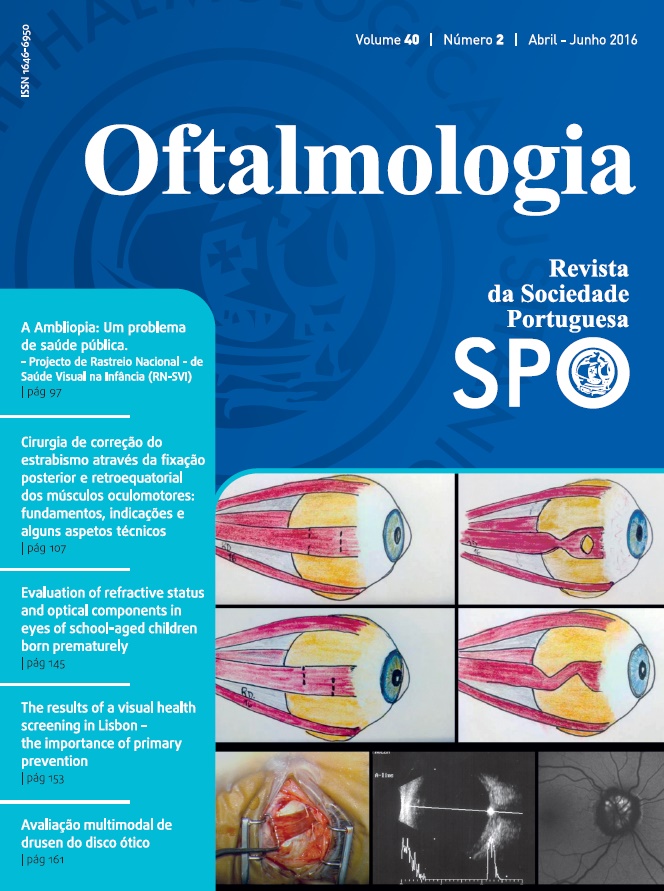Scheimpflug Imaging for Evaluation of Optical Components in Portuguese Children with history of preterm birth
DOI:
https://doi.org/10.48560/rspo.7437Keywords:
Câmara anterior, córnea, miopia, perto pre-termo, retinopatia da prematuridade.Abstract
Abstract. Purpose: To evaluate anterior segment (AS) using Scheimpflug Imaging and refraction in children with preterm birth with and without Retinopathy of Prematurity (ROP).Methods: In a cross-sectional study, 39 eyes of premature patients without ROP (Group 1) and 39 eyes with history of ROP (Group 2) between 9 and 17 years old were evaluated with PENTACAM after cycloplegia. Visual acuities, refractive errors and AS parameters (central corneal thickness (CCT), anterior chamber volume, anterior chamber depth, iridocorneal angle, lens thickness) were evaluated in all Groups. Clinical history such as gestational age at birth, birth weight, time of oxygen exposure, Stage of ROP in maximal severity of acute disease and ROP treatment were questioned. Results: Scheimpflug imaging showed a significant difference in CCT with lower values in group 2 (p<0,05). Stage of ROP and time of oxygen exposure showed significant impact on CCT. Group 2 showed also lower anterior chamber volume and depth.Lens thickness was higher in Group 2, particularly in eyes with treated ROP and was positively correlated with ROP stage and time of oxygen exposure and negatively correlated with gestational age and weight at birth. Conclusions: AS anatomy is different in premature eyes without ROP compared with eyes with history of ROP. The eyes with history of ROP have shallower anterior chamber and greater lens thickness than premature eyes without ROP. These differences in AS could explain the higher incidence of myopic shift in eyes of children with history of ROP.
Keywords: anterior chamber, cornea, myopia, preterm birth, retinopathy of prematurity.
Resumo. Objetivo: Avaliação de refração e do segmento anterior (SA) com sistema de imagens Scheimpflug em crianças com antecedentes de parto pre-termo. Métodos: Estudo transversal com pacientes entre 9 e 17 anos divididos em 2 grupos principais: crianças com história de prematuridade sem ROP (grupo 1) e com ROP (grupo 2). Parâmetros do SA foram avaliados com PENTACAM após cicloplegia: espessura central da córnea (ECC), volume da câmara anterior, profundidade da câmara anterior, ângulo iridocorneano e espessura do cristalino. Acuidades visuais e erros refrativos foram também avaliados. Os antecedentes clínicos, como a idade gestacional, o peso ao nascer, o estadio da ROP na severidade máxima da doença aguda, tipo de tratamento efetuado e complicações neonatais foram obtidos. Resultados: Verificaram-se valores mais baixos de ECC no grupo 2 (p<0,05). O estadio da ROP e o tempo de exposiçãp ao oxigénio foram os fatores com maior impacto na ECC. O grupo 2 revelou um volume e profundidade de câmara anterior (CA) mais baixos. A espessura do cristalino foi superior no grupo 2, particularmente nos olhos com história de ROP tratada e correlacionou-se de forma significativa e positiva com o estadio da ROP e o tempo de exposição de oxigénio. Por sua vez, correlacionou-se de forma negativa com a idade gestacional e peso ao nascer. Conclusões: Os olhos com história de ROP apresentam uma CA mais estreita e cristalino mais espesso do que os olhos prematuros. Estas diferenças poderão explicar a elevada incidência de shift miópico nos olhos com história de ROP.
Palavras chave: Câmara anterior, córnea, miopia, perto pre-termo, retinopatia da prematuridade.
Downloads
Downloads
Additional Files
Published
How to Cite
Issue
Section
License
Do not forget to download the Authorship responsibility statement/Authorization for Publication and Conflict of Interest.
The article can only be submitted with these two documents.
To obtain the Authorship responsibility statement/Authorization for Publication file, click here.
To obtain the Conflict of Interest file (ICMJE template), click here





